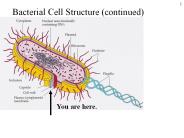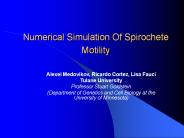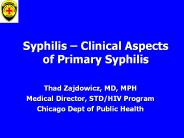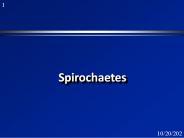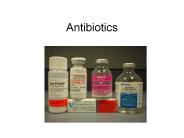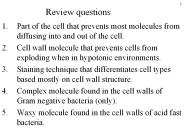Spirochetes PowerPoint PPT Presentations
All Time
Recommended
Human encroachment into habitat of white-tailed deer. Spread from deer, mice to humans by the bite of soft ticks. adults, nymphs ...
| PowerPoint PPT presentation | free to view
... causes leptospirosis, a zoonosis Bacteria shed in urine; infection occurs by contact with contaminated urine; targets kidneys, liver, brain, ...
| PowerPoint PPT presentation | free to view
flu-like symptoms. skin, particularly. many organisms. mouth muosa. 10. Tertiary. several years later ... in US. symptoms. flu-like. severe systemic disease ...
| PowerPoint PPT presentation | free to view
CDC * Lyme disease ... response develops disease relapses new antigens expressed no immunity disease reappears * Diagnosis no culture no serological test detected ...
| PowerPoint PPT presentation | free to download
Lyme disease. Relapsing fever (other borrelia) Leptospira (leptospirosis) Neisseria ... scapularis, tick vector for Lyme disease. Also known as Ixodes dammini. ...
| PowerPoint PPT presentation | free to download
CDC * Lyme Disease erythematous rash ... response develops disease relapses new antigens expressed no immunity disease reappears * Diagnosis no culture no serological ...
| PowerPoint PPT presentation | free to download
Spirochetes. Gram ve, slender, cork-screw shaped. Periplasmic flagella. Outer sheath (covering membrane mask the antigens. Organisms. 1. Treponema pallidum ...
| PowerPoint PPT presentation | free to view
About 1/3 did make a homemade diary. ... FREE SPIROCHETEs? Shift to metronidazole. plus azithromycin, with minimal pos. effect ...
| PowerPoint PPT presentation | free to download
louse: scratching crushes louse; bacteria released. enter abraded area or bite area ... symptoms associated with bacteria in blood (not. known how bacteria get ...
| PowerPoint PPT presentation | free to view
Miscellanous bacteria Mycoplasma, Ureaplasma, Chlamydia Ricketsiaceae Spirochetales - Spirochetes, Leptospira, Borrelia Mycobacterium Nocardia , Actinomycetes,
| PowerPoint PPT presentation | free to view
Spirochete Diseases Terry Kotrla, MS, MT(ASCP)BB Fall 2005 Introduction to Spirochetes Long, slender, helically tightly coiled bacteria Gram-negative Aerobic ...
| PowerPoint PPT presentation | free to view
Canine Lyme Disease. Borrelia burgdorferi. Helical-shaped unicellular spirochetes. Gram negative ... Lyme Disease. Humans. On May 22, 1989, Newsweek's cover ...
| PowerPoint PPT presentation | free to view
Lyme disease is the zoonosis disease that comes from the spirochetes bacteria in ... Rabies is a zoonosis disease found in the saliva in mammals. ...
| PowerPoint PPT presentation | free to view
2. Bacilli rod-shaped. Spirochetes spiral-shaped ... Thermophiles: live in hot water. Halophiles: live with high salt. Great Salt Lake ...
| PowerPoint PPT presentation | free to view
1-Mycobacteria-Chlamydia- Mycoplasam-Legionella 2- Spirochetes Prof. Dr. Asem Shehabi Faculty of Medicine University of Jordan Mycobacteria ...
| PowerPoint PPT presentation | free to download
"Copy Link : gooread.fileunlimited.club/pwjul24/0323509347 Greene's Infectious Diseases of the Dog and Cat 5th Edition Greene's Infectious Diseases of the Dog and Cat, 5th Edition provides a comprehensive, clinically useful reference on the management of infectious diseases caused by viruses, bacteria (including rickettsiae, chlamydiae, mycoplasmas, and spirochetes), fungi, algae, protozoa, parasites, and other atypical agents. Each section guides the reader through diagnostic testing for specific infectious diseases, from specimen collection to laboratory submission to interpretation of results to appropriate treatment measures. Full-color illustrations and hundreds of tables provide convenient access to diagnostic and therapeutic recommendations, along with the appropriate drug dosages for effective treatment and prevention. A fully searchable enhanced eBook version is included with print purchase, allowing access to all of th"
| PowerPoint PPT presentation | free to download
The spirochaetes in a thick blood smear are sometimes very slender ... Treponema pallidum. In exudate from an indurated chancre ( Fontana-Tribondeau stain) ...
| PowerPoint PPT presentation | free to view
Teeth help us to chew and digest food. They help us to talk, and to pronounce different sounds clearly. Finally, teeth help to give our face its shape.
| PowerPoint PPT presentation | free to download
Anthrax Botulism Tuberculosis (TB) Leprosy Salmonella Kingdom Monera Cell wall Prokaryotes Ribosomes Chromosome 5. No nucleus 5. PLASMIDS 6. Bacteria anaerobic 7.
| PowerPoint PPT presentation | free to download
Bacterial Motility Hugh B. Fackrell Presentation Outline Bacterial Flagella Location Function Structure Bacterial vs eukaryotic flagella Flagellum vs Pilus Pilus ...
| PowerPoint PPT presentation | free to download
Title: PowerPoint Presentation Author: Carl Castles Last modified by: Information Technology Created Date: 6/30/2004 7:16:44 PM Document presentation format
| PowerPoint PPT presentation | free to view
Teeth help us to chew and digest food. They help us to talk, and to pronounce different sounds clearly. Finally, teeth help to give our face its shape.
| PowerPoint PPT presentation | free to download
Lyme Disease inflames the joints. If not treated it could lead to arthritis. ... Antibiotics are given to patients with Lyme Disease. ...
| PowerPoint PPT presentation | free to view
Information about Genus Treponema, endemic & venereal Syphilis. A perfect guide for Medical microbiology and Bsc Microbiology students
| PowerPoint PPT presentation | free to download
Small mammals (mice, squirrels, chipmunks, etc.) Birds. Hosts for the tick include ... Eastern chipmunk. Virginia opossum. Raccoon. Questing nymphs. 90% 32 ...
| PowerPoint PPT presentation | free to view
... uterine prolapse fusarium estrogenictoxin uterine prolapse fusarium estrogenictoxin culture of fusarium moldy feed swine dysentery ... greasy pig disease s ...
| PowerPoint PPT presentation | free to view
Ancient fossils 3.5 billion years b.p. Archetype for prokaryotic organisms. Phototrophs ... Mutualists (bacteria and host both benefit) Unicellular, colonial, ...
| PowerPoint PPT presentation | free to download
(source: Karen V. Forschner: Everything You Need To Know About Lyme disease) ... lead to further studies on the role and function of these forms in Lyme disease. ...
| PowerPoint PPT presentation | free to download
Title: Effect of osmotic pressure on cells Author: DGILMORE Last modified by: Dr.s Gilmore Created Date: 1/24/2004 6:45:31 PM Document presentation format
| PowerPoint PPT presentation | free to download
Survey of Microbes Part I: Important prokaryotes Gram negative organisms, archaea, and others IMPORTANT GRAM NEGATIVE PROTEOBACTERIA G- cocci Neisseria: _____ N ...
| PowerPoint PPT presentation | free to view
Title: Survey of Microbes Part I: Important prokaryotes Author: Dana Nayduch Last modified by: LONNIE Created Date: 9/13/2005 1:44:04 AM Document presentation format
| PowerPoint PPT presentation | free to view
Telling The Truth my experiences with Lyme borreliosis
| PowerPoint PPT presentation | free to view
Title: Effect of osmotic pressure on cells Author: DGILMORE Last modified by: DGILMORE Created Date: 1/24/2004 6:45:31 PM Document presentation format
| PowerPoint PPT presentation | free to download
Dental Conference - MID Periodontal Disease November 11, 2004 Destructive Periodontal Disease Dental plaque biofilm infection Ecological point of view Ecological ...
| PowerPoint PPT presentation | free to download
MICROBIOLOGY OF PERIODONTAL DISEASE ... Plaque control Root surface debridement Periodontal surgery Prudent use of antimicrobial agents Page ...
| PowerPoint PPT presentation | free to view
Serodiagnosis of Lyme Disease by Kinetic Enzyme-Linked Immunosorbent Assay Using ... Adaptation of the Lyme disease spirochaete to the mammalian host environment ...
| PowerPoint PPT presentation | free to view
Rodent / domestic animal reservoir. Animals - asymptomatic disease. Humans are accidental hosts. ... L interrogans & L biflexa (free living) Tightly coiled ...
| PowerPoint PPT presentation | free to view
Human Oral Cavity Made by Luan Yijun, Zhang Yanhui, Liu Junying, Li Na, Xuxia, Liu Song, Wang Ge, Zhang Tianqi, Ying Wanggui, Li Shengfeng 1.Normal flora in human ...
| PowerPoint PPT presentation | free to view
Adjuvant. 0.2% Al(OH)3. Anti-OspA titres. Day 42. 28. B i o S c i e n c e ... OspA combined with 0.2% (w/v) Al(OH)3 as adjuvant ...
| PowerPoint PPT presentation | free to view
Numerical Simulation Of Spirochete Motility Alexei Medovikov, Ricardo Cortez, Lisa Fauci Tulane University Professor Stuart Goldstein (Department of Genetics and Cell ...
| PowerPoint PPT presentation | free to download
Bacteria Structure and Function Prokaryote & Eukaryote Evolution Cellular Evolution Current evidence indicates that eukaryotes evolved from prokaryotes between 1 and ...
| PowerPoint PPT presentation | free to download
Department of Population Medicine and Diagnostic Sciences, College of Veterinary ... Digital Dermatitis, Hairy Heel Warts, Mortellaro ...
| PowerPoint PPT presentation | free to view
mbbs program gda module department of anatomy teratogens & congenital anomalies presented by prof / yousry m shawky ...
| PowerPoint PPT presentation | free to view
Medical Director, STD/HIV Program. Chicago Dept of ... 'Kissing' Chancres 'Kissing' Chancres. Perianal Chancre. Chancre of the Tongue. Oral Chancre - Lip ...
| PowerPoint PPT presentation | free to download
Prokaryotes and Protists Chapter 16
| PowerPoint PPT presentation | free to view
1 ds circular loop of DNA. Shapes of the Bacteria. Bacillus. Coccus. Vibrio. Spirillum. Spirochete. Pleiomorphism- Some bacterial shapes vary within a culture. ...
| PowerPoint PPT presentation | free to view
... growth of competition when nutrients are in short supply Sporulation Resting cells Cells respond to low nutrients by sporulation or slowing down metabolic rate ...
| PowerPoint PPT presentation | free to download
Bacteria Structure and Function Prokaryote & Eukaryote Evolution Cellular Evolution Current evidence indicates that eukaryotes evolved from prokaryotes between 1 and ...
| PowerPoint PPT presentation | free to download
Presentation Outline Morphology Organisms Diseases Leptospirosis Lyme disease Syphilis Tests Spirochete Morphology Gram negative cell wall often too small to see by ...
| PowerPoint PPT presentation | free to download
rod shaped, Gram negative, lophotrichous. chemoheterotrophs. Pseudomonas ... Sulfolobus (hot springs of Yellowstone National Park) - oxidizes sulfur ...
| PowerPoint PPT presentation | free to view
Eubacteria are
| PowerPoint PPT presentation | free to view
NAG. NAG. NAM. NAM. NAM. NAG. NAG. NAM. NAM. NAM. NAG. NAG. Bond formation. inhibited by. penicillin. Cross linking ...
| PowerPoint PPT presentation | free to download
... capsules and slime layers Fimbriae and pili Fimbriae and pili-2 Flagella Flagellar structures Motility revisited Axial filaments Review of eukaryotic ...
| PowerPoint PPT presentation | free to download
Mutualists (bacteria and host both benefit) Unicellular, colonial, filamentous ... phototaxis: movement toward light. chemotaxis: movement to chemicals ...
| PowerPoint PPT presentation | free to download
Prevention of Lyme disease ... The History of Lyme Disease ... Learn about Lyme Disease. ...
| PowerPoint PPT presentation | free to view






























